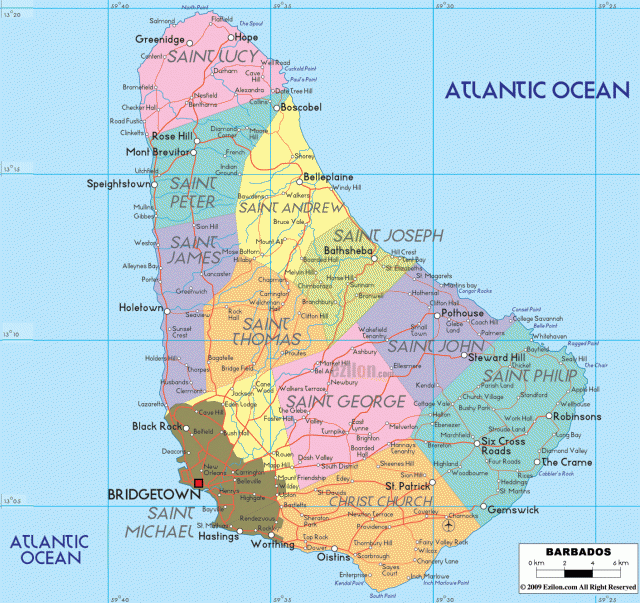Barbados
Area 168 square mi (431 square km)
Population 286,100 2014
Capital Bridgetown
Highest Point Mount Hillaby 1,109 ft (336 m)
Lowest Point 0 m
GDP $4.348 billion 2014
Primary Natural Resources petroleum, fish, natural gas.
BARBADOS IS ONE of the clearest success stories of the CARIBBEAN SEA, with one of the most prosperous economies and stable governments in the region. Having one of the highest population densities in the world (1,548 per square mi), Barbadians were also one of the first nations (in 1955, second only to INDIA) to implement a family planning program, which has resulted in one of the lowest birthrates in the Western Hemisphere. Much of the current population growth is due to the return of Barbadians who emigrated to the UNITED KINGDOM (UK) in the 1950s and are now retiring back home. For most people in 18th-century Britain, Barbados was the Caribbean—British settlers had been on the island since 1627; its main town, Bridgetown, was a large, bustling trade city, and the colony had become the largest and wealthiest of all the English colonies, surpassing VIRGINIA and MASSACHUSETTS. The colony had over 40,000 English residents, and one of the oldest legislatures in the New World.

Lying about 100 mi (161 km) east of the main arc of the Antilles, the island was usually the first port of call for Europeans crossing the ATLANTIC OCEAN. The Portuguese had first named the island “bearded ones,” after the bearded fig trees they found there. There were no original inhabitants at first encounter, so there was no resistance to overcome for the great number of planters who came to set up small farms for tobacco, cotton, and indigo.
The land is relatively flat, with a gentle rise to a central highland. As part of the eastern arc of the Antilles (including Antigua, St. Martin, and ANGUILLA), any volcanic activity is much more distantly removed, and the older, more weathered soil, is very rich and commercially viable on a large scale, especially in the central highlands. The “sugar revolution” of the 1640s to 1680s thus began here and ultimately changed the overall economy of most of the region. As small farms were replaced with large plantations, most English landowners were squeezed out by the sugar barons and resettled in the Guianas and SOUTH CAROLINA, replaced by large numbers of slave laborers imported from Africa. Barbados was the center of the sugar-producing world until the abolition of slavery in 1834, but the industry continued to dominate, run both by freed Africans (the majority of the population), and some descendants of white laborers (called “Red Legs”).
Barbados was one of the first British colonies to achieve independence, in 1966, with one of the easiest transitions to self-rule. It remains an active member of the Commonwealth, with the British monarch continuing to serve as chief executive. Production and export of sugar have declined in the past 30 years, but locally produced rum remains a specialty. Agriculture has become more diverse, producing more vegetables and fruits for domestic consumption, but much of its food is still imported. More than 80 percent of the population is employed in service industries, mostly tourism. Tourists generally come from the UK, not from the UNITED STATES, so Barbados retains its British style in many ways more than its Caribbean neighbors (the closest being St. Vincent and the Grenadines). There is a growing U.S. presence in the data processing industry, taking advantage of the very literate Barbadian population (99 percent).